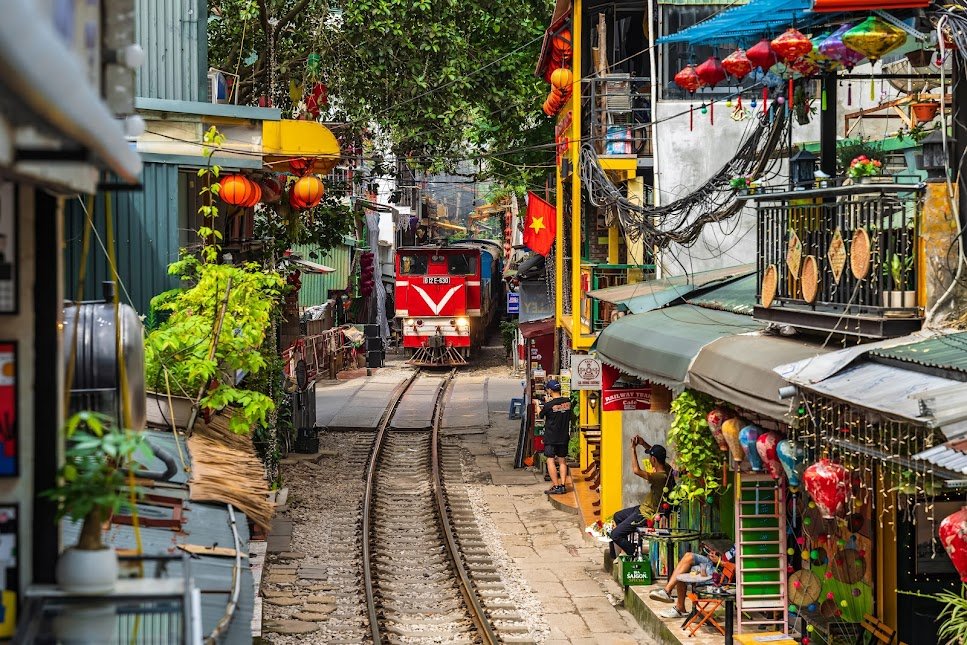Contents
ToggleWhere to Find Hanoi Train Street
Hanoi Train Street is not just one fixed location but rather a stretch of railway track that cuts straight through the heart of the city. It begins at Long Bien Station, a historic French-built terminal, and runs all the way south to Hanoi Central Station, weaving past homes, shops, and street markets. Along its route, the track threads through neighborhoods on Phung Hung, Tran Phu, Dien Bien Phu, and Le Duan streets, creating some of the most atmospheric urban scenes in Hanoi.
📍 The most famous section—the one you see all over Instagram—is located where the tracks make tight curves between houses. Here, the train seems to bend dramatically through impossibly narrow spaces, creating an almost cinematic moment.
- Best starting point for visitors: The corner of Dien Bien Phu Street and Ton That Thiep Street. From this intersection, you can follow the railway southwards along Tran Phu and then toward Phung Hung Street, where small cafes line both sides of the track.
- The Old Quarter stretch around Phung Hung Street is the liveliest and most photogenic part of Train Street, with residents, travelers, and coffee shops all sharing the same narrow corridor.
👉 Local Tip: After exploring Train Street, make a short detour to the Phung Hung Street Murals nearby. This open-air art gallery features dozens of hand-painted arches that tell the story of Hanoi’s past—from old-fashioned trams and flower vendors to scenes of Tet celebrations. It’s a quieter, more reflective complement to the high-energy experience of Train Street.
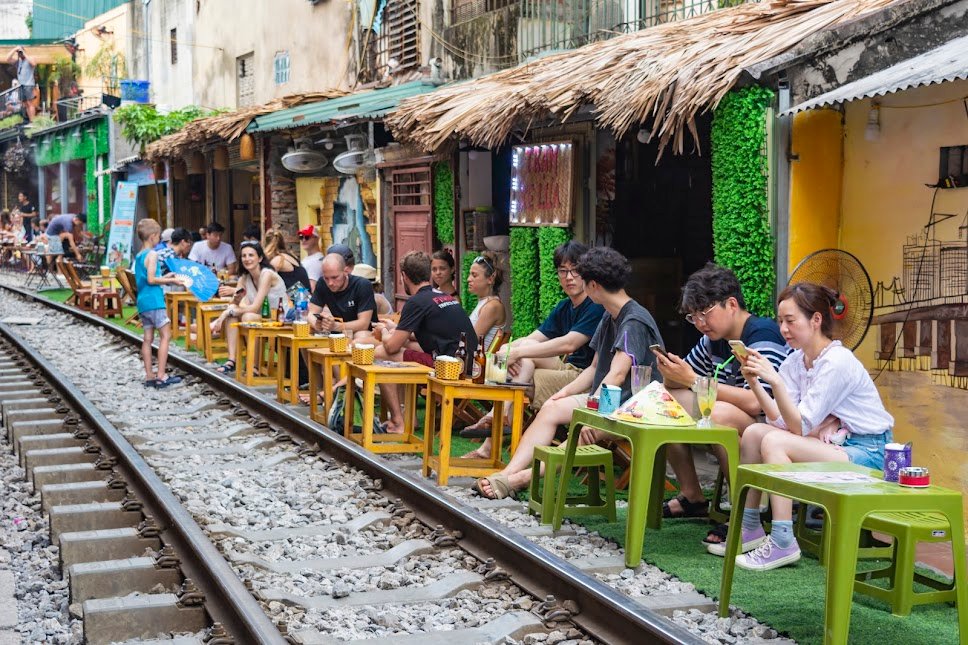
Why Hanoi Train Street is So Special
🚂 A Railway with Over 100 Years of History
Hanoi Train Street is not a modern curiosity created for tourism—it is a living relic of history. The railway was built during the French colonial period in the early 20th century, part of a wider rail system that connected Hanoi with northern Vietnam and beyond. For more than a century, trains have rumbled down these tracks, long before the cafes and tourists arrived.
What makes the street remarkable today is not just its age, but its intimacy: the tracks run within arm’s reach of houses and balconies, sometimes just one or two meters away. When a train approaches, it feels as if the locomotive is about to scrape the walls, and the entire neighborhood seems to hold its breath. For many first-time visitors, this heart-pounding moment is both thrilling and surreal—a travel memory that stays with you forever.
🏠 Daily Life on the Tracks
Equally fascinating as the trains themselves is how seamlessly local life has adapted to the railway. In between scheduled trains, the track is not an obstacle—it is an extension of the neighborhood.
- Families use the railway as a courtyard: drying clothes, preparing vegetables, or fixing scooters.
- Children chase each other or play games right on the gravel.
- Elderly neighbors set up tiny stools, sipping green tea or chatting casually as if the rails were a village square.
The most magical part is the transformation that happens in seconds. As soon as the train whistle sounds in the distance, the scene changes. Chairs, bicycles, food stalls, and laundry racks vanish as residents pull everything back into doorways. Within moments, the track is clear, and the train thunders past with a deafening roar. Just as quickly, life spills back out, calm and cheerful, as though nothing happened.
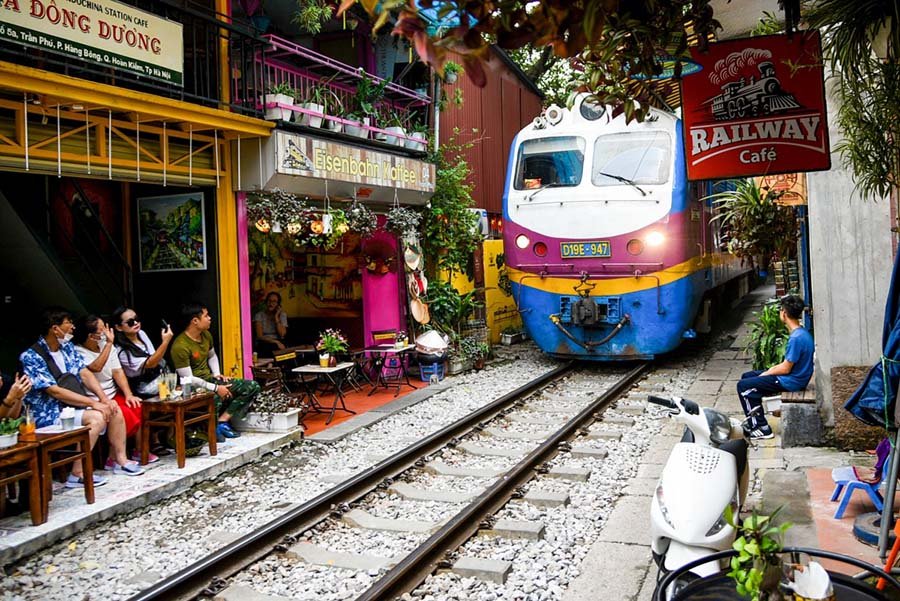
Hanoi Train Street Timetable (2025 Update)
If seeing a train thunder just inches away is on your Hanoi bucket list, timing is everything. Trains do not pass every hour, so you’ll need to plan carefully to avoid disappointment.
📅 Current Train Schedule (as of 2025):
- Monday to Friday: 3:30 PM & 9:15 PM
- Saturday & Sunday: 3:30 PM & 9:30 PM
👉 Pro Tip: Arrive at least 30 minutes early. This gives you enough time to find a good seat at one of the trackside cafés, order a drink, and soak up the atmosphere before the train rushes through. The wait is half the fun—watching locals prepare, seeing travelers set up cameras, and then hearing the first whistle echo down the street creates an unforgettable sense of anticipation.
⚠️ Keep in mind: Trains can occasionally be delayed, especially during rainy season or holidays. Some cafés post real-time updates, so it’s worth asking staff about the latest schedule when you arrive.
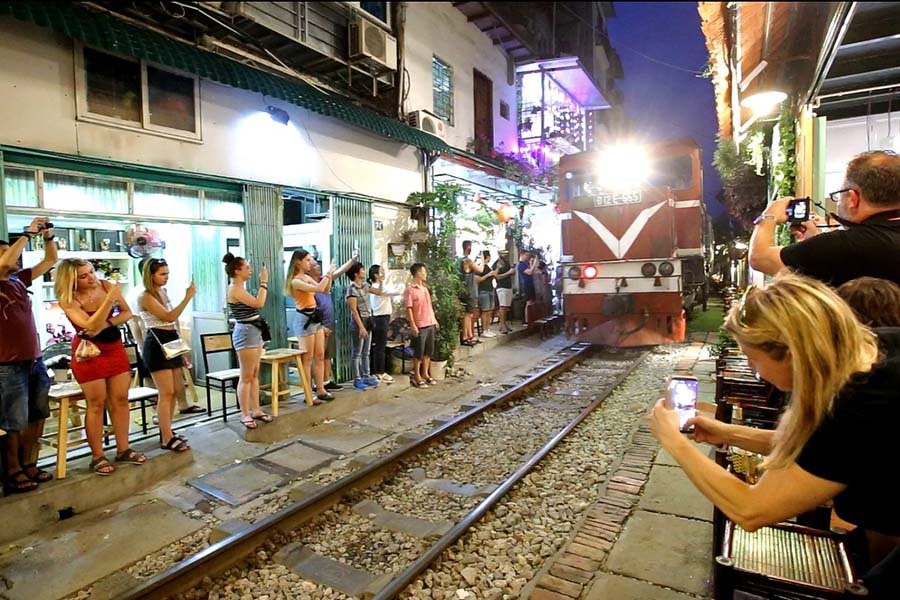
Is Hanoi Train Street Still Open?
This is one of the most common questions travelers ask, and the answer is: Yes — but with conditions.
In September 2022, Hanoi authorities temporarily closed off access to certain parts of Train Street, citing safety concerns after overcrowding and tourists standing too close to the tracks. Barriers were set up, and many cafés were forced to shut down or adapt.
Since then, a balance has been struck between tourism and safety:
- ✅ Many cafés along the tracks have reopened after agreeing to follow strict safety measures.
- ✅ Visitors are welcome to sit, enjoy coffee, and experience the train up close.
- 🚫 During train times, you must remain inside the cafés or in clearly designated safe zones. Standing directly on the tracks is no longer allowed.
- 👮 Railway guards and café staff coordinate to ensure everyone clears the tracks in time.
- 📺 Electronic boards now display train schedules and safety reminders in multiple languages.
For travelers, this means you can still enjoy the thrill of Train Street—watching a massive locomotive pass just inches from your table—without the previous risks of overcrowding.
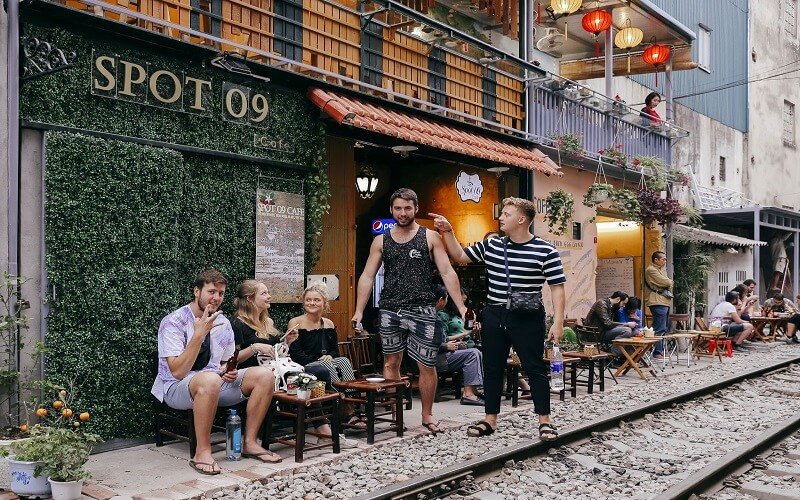
Final Thoughts
Hanoi Train Street isn’t just an Instagram hotspot — it’s a living piece of history, blending the charm of old Hanoi with the thrill of modern-day travel.
Watching a train squeeze past homes and cafes just inches away is unforgettable. But while you’re there, remember to stay safe, follow local rules, and respect the residents who call this extraordinary place home.












